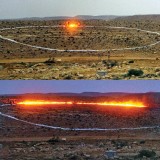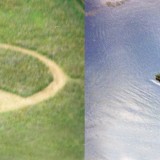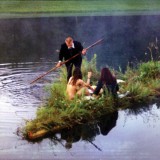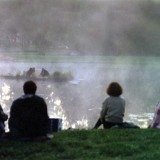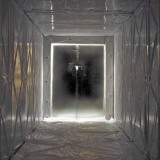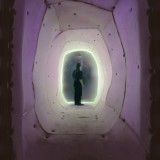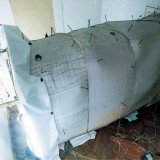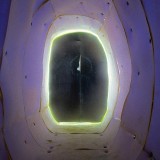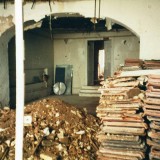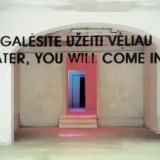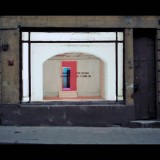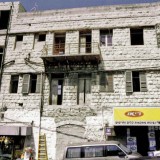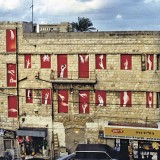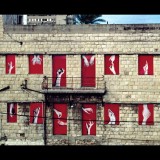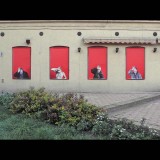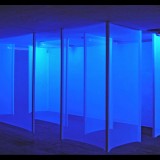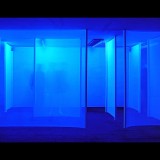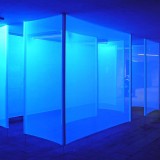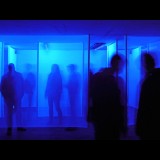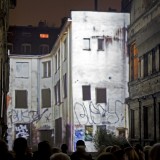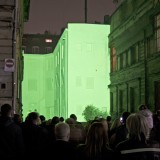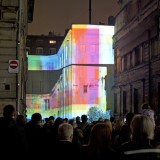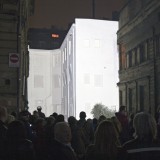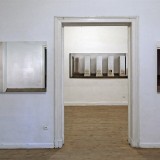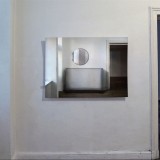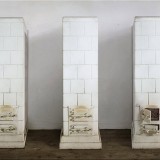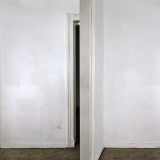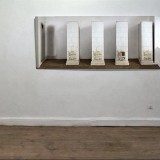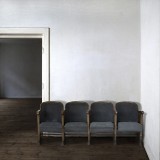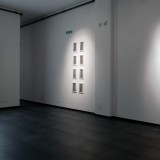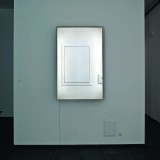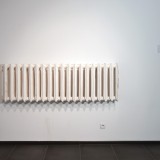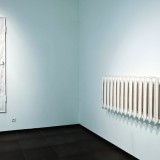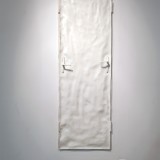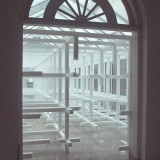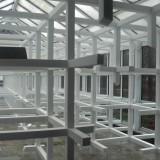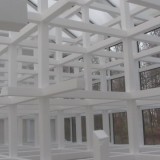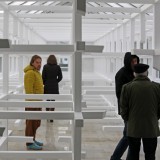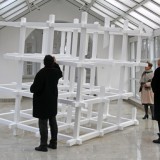Tomasz Matuszak
Tomasz Matuszak (born 1967 in £ódľ). His art. is tightly associated with the concept of space as understood in various aspects. The artist is a graduate of the Academy of Fine Arts in £ódľ (then the Art College), which he finished in 1993 after he defended his diploma within the Department of Graphics. Now he lectures in the same school in the Studio of Sculpture. The artist is associated with the Wschodnia Gallery in £ódľ and he has participated in initiatives co-created by the gallery – Construction in Process and the Artists’ Museum.
In spite of the fact that Matuszak started from working with canvas and a flat surface, from the very beginning of his artistic road, he showed interest in the relationship between the artwork and the concrete space and interference by an art action within a given space. Although the starting point for his work was the flat surface of a painting, it became more and more difficult for him to operate within this frame. Canvas in large form annexed the space but at the same time was a harbinger of the artist’s road, which was supposed to lead outside of traditional painting, passing the borders into a sculptural object.
In 1993 in the 86 Gallery in £ódľ, he showed paintings in large formats, to which he attached rods, steel sheets and pipes. He connected paintings using cables glowing with electric light and with the sculptures of human corpses made of plastic. Matuszak abolished the border between the work of art and everything outside of it – paintings, objects, the gallery space and viewers became an organic whole. With this action he gave up modernist thinking about the work of art – an object isolated from life, which in the 90s still strongly dominated in Polish academic teaching. Instead he followed in the footsteps of the environment and installation artists, as well as conceptual practicioners.
In 1995 as part of the 6th Construction in Process he made a spectacular action at the Negev Desert in Israel. On a vast open plane he arranged a circle using cotton yarn, which he burned at sunset. The circle glowed with the light of the fire when the sun was hiding behind a horizon. In this way the artist attempted for a while to stop the energy of the sun on Earth. Matuszak shows in contemporary art the theme of the elements, often undertaken through the history of art. He used fire again in the same year in Berlin during his action Unsuccessful attempt to teleport or: you will never escape from here. The action reflected his fascination with and at the same time his critical view of science fiction movies. Matuszak performed wrapped in silver foil, locked in a cage which was to burn for a while and in this way, symbolically move him into the future. The situation, however, slipped out of control and the artist found himself inside a burning cage without the possibility of escape. When he entered half-conscious on a stretcher into hospital room number 2001 he thought: “I’ve made it”.
In 1996 he was a resident at the artists’ colony Art/Omi in New York state. He was immediately struck by the idyllic atmosphere of this place – a Victorian house with a park and meadow surrounding it. The artist decided to interfere in this landscape. He cut a piece of grass with the soil out of the meadow and made a disturbing gap. He moved the cut off sod of grass to the bank of the river, where with two female artists’ – one naked and one dressed up, they had Breakfast on a raft. By quoting the 19th century Manet painting with only a small change in the title, he fit into the character of this somehow frozen in time estate. He moved a piece of European art to America and a fragment of soil to water. He also worked with the element of water in 1997 in Abu Mounth in India. Together with Meg Belichick they placed three circles made of flowers on a lake – Shiva’s Tears. In this work they surrendered to the local atmosphere as the inhabitants were not familiar with art in a Western sense of the word. The activity of the artists was only understood when they replied to people that their work is an homage to Shiva. After his pilgrimage from India, Matuszak decided to bury himself in the soil. He started from his head. Burying heads was a meditative and penitent practice of Indian monks. When asked about his experiences, the artist said it was unusual. First a feeling of panic and claustrophobia, then cold and great calmness followed by a pleasant smell and a feeling of total isolation from everything.
In his installations Hyper-nation shown in the ZachÍta Gallery in Warsaw and The inner side of outer space presented in the Wschodnia Gallery, Matuszak researched the penetration of the interior and exterior. Hyper-nation was described by the Warsaw press as a cool room of an ice-cold colour– an isolation ward in a mental hospital. Opposite the viewer there was a metal wall, from behind which one could hear the obsessive breath of someone of whom we were afraid to imagine. Hyper-nation was a response to frequent contemporary stances, when we become superhuman beings in our own eyes and we behave as such. In the Wschodnia Gallery the viewers also entered the strange structure, but the way it was made – with an intended sloppiness and a flimsiness, destroyed the borders of safety and caused uncertainty among people who found themselves in a strange tunnel, which could collapse at any minute.
Many of Matuszak’s works have a performative or time-based character. In 1997 in Vilnius he was invited to present an action in an abandoned, ruined room with a storefront. Matuszak carefully renovated the space and painted it white. Then he placed a sign in the window – “Later you will come”. The process of tidying up the space was a part of the process of creating art. Matuszak found the place deteriorated. He left it clean and prepared for those who would like to act there in the future.
In 2001 he changed a building in Arabic Haifa into a huge installation in the public environment. On a sandy façade of the building, in the window openings, he composed paintings of hands on an intensively red background. The hands were in various gestures, but the interpretation and understanding depended on the viewer and his/her culture, just as cultural divisions cause misunderstandings and obstacles in communication, in the neighbourhoods where, Arabs and Jews live in a constant conflict. Intensively red background was also used by the artist in an installation Kings in £ódľ during Fokus £ódľ Biennale 2012. The artist photographed the local homeless people which are a fixed element of Piotrkowska street. In the photos all of them raise their hands over their heads in a characteristic way, and create a kind of a crown over their faces.
He had referred earlier to the issue of homelessness during the Fluo-Session Festival where in 2008 he made a Virtual House in an underpass which led to a non-existing station £ódľ Fabryczna. Matuszak brought attention to the space using an essence of fluorescent light, which is opposite to natural light. The Virtual House was the opposite to the idea of a genuine house – a place when one can hide, relax and feel safe far from unwanted looks. Homeless people who live in railway stations do not have such a possibility. In the “house” created by Matuszak one cannot hide or lock oneself away. The walls are transparent and everyone can enter. The plan of the Virtual House was based on the plan of Matuszak’s apartment.
The next theme in Matuszak’s art are works which are a kind of a tautology of a place – works in a given space, whose topic is the space itself. In the Wschodnia Gallery during the Exhibition that never has been he showed a series of photographs presenting fragments of the rooms in the Wschodnia Gallery. The photos were in fact photomontages in which the artist added some elements to the interior, changed their order or on one photo, showed the windows which face Wschodnia St. – one during the day and one at night. In the Imaginarium Gallery in £ódľ in one of the series of works presented during the exhibition entitled Blow up he paid attention to the necessary elements of the interior, which were supposed to be as natural as possible in the gallery space, but they are not necessary that way. He showed a lightbox on which he photographed close-up an electric installation box and a socket, and on the wall he hung the door and a heater in the middle of it. This way he brought attention to the fact that even in a very neutral “white box” space we’ll find simple elements which break this convention.
In 2013 in the Centre for Polish Sculpture in OroŮsko in the Orangery Gallery he made an installation Broken Structure based on architectonic divisions within the glassed part of the building. He entered the rhythm of these divisions to the interior and this way annexed the space. The artist however broke the geometric divisions and made defects and gaps in the construction grid. This interference gave the impression that the elaborate structure may fall down in a second. Tomasz Matuszak is an artist who is very sensitive towards the context of the space and to addressing the qualities brought by the space. These are the inspiration and material out of which his art emerges – art dedicated to the space.
Anka Le∂niak
more at the artist's web site:
http://www.tomaszmatuszak.art.pl/


